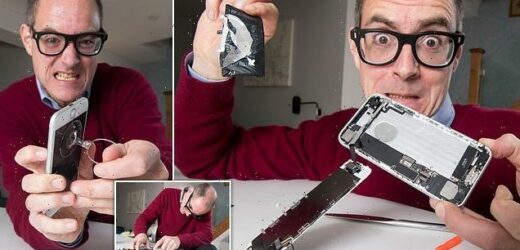I tried to change my iPhone battery… and nearly blew up the kitchen! We’re all trying to move on from the ‘throwaway’ culture. So why, asks HARRY WALLOP, do they make it so difficult to rescue our old gadgets?
- Harry Wallop decided to rescue an old iphone 7 with new battery
- The UK has an estimated 527 million ‘small old electricals’ and he decided to save the planet and a few pounds by replacing battery himself
- He gives his verdict on his experience of trying to change the battery
How hard can it be? ‘I really don’t think it’s difficult,’ Junaid Syed reassured me. ‘I always say if you can assemble a piece of Ikea furniture, you can replace a smartphone screen or battery.’
Junaid is the co-founder of SarasFix, a mobile phone repair shop in central London. So with his reassuring words ringing in my ears I attempted to replace a worn-out battery inside an old iPhone 7. Apart from the fact the battery ran out of juice after just a few hours, the phone was in good working order.
My thinking was: why spend £389 on the cheapest new iPhone, when I could rescue an old one with a new battery? Save the planet and a few pounds into the bargain.
Surely it’s a matter of loosening a few screws, popping off the back and slotting in a new battery. Isn’t it?
The UK has an estimated 527 million ‘small old electricals’, an average of nearly 20 per household, languishing in drawers and cupboards under the stairs, according to campaign group Recycle Your Electricals. Nearly all could have a useful life if batteries, screens, cables or internal parts were mended.
So with his reassuring words ringing in my ears I attempted to replace a worn-out battery inside an old iPhone 7, writes Harry Wallop
Yet Britain has a shameful record when it comes to sending our unwanted electricals to landfill. We are the second-highest producer of electronic waste in the world per capita, according to recent UN data, with each of us throwing away almost 24kg of appliances and gadgets every year. Only Norway is worse.
But the backlash has started. Consumers increasingly want their electronics to last a decent amount of time. When it was revealed last week that Chris West, from Orpington, South-East London, was still using his grandmother’s trusty Morphy Richards iron from the 1940s, people were thrilled rather than horrified. Britain now has 156 ‘repair cafes’, where volunteers fix broken household goods, up from 92 just two years ago.
The Repair Shop, a BBC1 series which sees experts breathe new life into people’s much-loved products, went from pulling in 2 million viewers per episode to over 7 million during the most recent series, making it one of the BBC’s most popular shows.
And last month, Apple performed a major U-turn. After years of refusing to supply ordinary customers with spare parts, it announced that from next year it would offer ‘access to Apple genuine parts and tools’. It was a major victory for campaigners who have long argued for the right to repair.
After years of refusing to supply ordinary customers with spare parts, Apple announced that from next year it would offer ‘access to Apple genuine parts and tools’
The announcement from the Californian giant came after the British Government passed limited right-to-repair legislation earlier this year. Electronics manufacturers now have to make spare parts available for washing machines, washer-dryers, dishwashers, fridges and televisions for the first time.
Spare parts and instruction manuals for mending appliances have to be available up to ten years after the product has been discontinued. It was an important step, but a small one.
Laptops, computers and smartphones were not included in the legislation. And, in most cases, consumers do not have the right to get their hands on these spare parts. The law is intended to help professional plumbers or electricians.
If you search online for iPhone replacement screens, Samsung cameras or Nokia batteries, however, you can find a raft of companies supplying not just the components, but the tools, too. That’s because many people do want to mend their tech rather than throw it away — whatever the legislation may say.
‘Manufacturers estimate that the lifecycle of a laptop is five years and a smartphone is three years,’ explains Ugo Vallauri, co-founder of The Restart Project, which organises get-togethers where people can have their stuff mended.
‘But our data — from people who come into repair cafes and restart parties — shows that 40 per cent of all the laptops that people bring to get mended are older than five years. We’ve seen laptops as old as 11 years. The fact that people are trying to mend them means that they are still useful to them.’
If you search online for iPhone replacement screens, Samsung cameras or Nokia batteries, however, you can find a raft of companies supplying not just the components, but the tools, too
When I told him that I was going to replace the battery of a five-year-old iPhone, he said: ‘Good luck!’ and then laughed. ‘You will discover it’s not that easy.’
The first step, in fact, was easy. I went on to Amazon and searched for a replacement battery and kit for an iPhone 7. There were ten suppliers, all offering identical-looking equipment for less than £20.
Mine, from a company called LL Trader, cost £16.99 and contained, along with the battery itself, three screwdrivers, two mini plastic ‘crowbars’, a piece of plastic that looked like a guitar plectrum, a plastic suction cup and some intriguing-looking strips. There were no instructions.
But as Junaid Syed, who mends phones for a living and was bullish about my chances, said: ‘There’s lots of guides on YouTube telling you how to do it.’
He’s right. Various people recommended an American company called iFixit, whose guide to replacing an iPhone 7 battery informed me the process is ‘moderate’ in difficulty, will take me between 30 minutes and two hours and involves 29 stages.
What it does not warn you about is the cursing, the yanking, the sweat and the alarming smoke.
After removing some screws — at the bottom of the phone, next to the charging socket — you have to take the screen off.
What it does not warn you about is the cursing, the yanking, the sweat and the alarming smoke
But because it is glued on exceptionally tight, you have to use the plastic ‘spludger’, a mini crowbar, to prise it from the main body of the phone while using a suction device to jerk the screen loose.
I just couldn’t do it, despite pulling so hard I thought I’d snap the phone in two.
Vallauri had given me a tip: ‘Use a hairdryer.’ Yes, really. This replicates a professional electrician’s heatgun, designed to melt the glue that stops water entering the phone, he explained.
But even though I blasted my wife’s hairdryer at the phone for a good ten minutes, making the device too hot to touch, the glue just would not soften.
‘If they didn’t use adhesives in the design of the phone, you wouldn’t need to use a heat gun or hairdryer,’ says Vallauri. ‘It makes the job a lot more difficult for anyone who doesn’t mend phones for a living.
‘Too many people give up repairing a product because of the barriers; 30 per cent attempt to repair a product but give up because it’s either too expensive or too difficult.’
I was determined not to fail at step two of 29. So, I eventually reached for the cutlery drawer. The plastic tools that came in the kit didn’t seem robust enough, a steel knife with a thin blade was needed. Bingo! It worked. The screen popped loose.
The plastic tools that came in the kit didn’t seem robust enough, a steel knife with a thin blade was needed
My elation was short-lived, however. Next, I needed to remove the battery, which was hardwired into the phone. This was not a simple process.
First, I had to unscrew the smallest screws I have ever encountered: 1.2mm in length, so small they could be mistaken for a bit of grit.
Worse, they were all slightly different sizes, requiring different screwdrivers, and the guide suggested I purchase a magnetic mat, in order that they did not roll away. I stored mine in an egg cup.
I then had to remove various components so that I had a clear run at the battery, with a warning from the guide: ‘If the connector is even slightly misaligned, the connector can bend, causing permanent damage.’
I felt like Gulliver in Lilliput, with my fingers vast sausages in a land of minuscule wires and sockets. At every move, I feared I was about to break my expensive phone.
Eventually, I was ready to use a pair of tweezers to pull out two strips of adhesives that were glueing in the battery. Then disaster struck! The adhesive strips snapped.
The guide warned me this was to be avoided at all costs, and the only solution was to apply 90 per cent isopropyl alcohol or thread a guitar string behind the battery in an attempt to prise it loose. I had neither to hand.
First, I had to unscrew the smallest screws I have ever encountered: 1.2mm in length, so small they could be mistaken for a bit of grit
But I did have my trusty piece of cutlery, so I slid the knife under the battery and started to wiggle. No joy. So, I used a bit more force to lever the power bank free, only for the battery to bend and emit a strong smell of nail varnish remover.
Just as I was contemplating how odd it was that a battery should smell of pear drops, smoke started to billow out. Woah!
I dropped the phone and took a sharp step back. Only then did I spot in the guide the warning: ‘A charged lithium-ion battery can catch fire or explode if accidentally punctured.’ Luckily, the smoke did not turn into flames and I was able to get the battery out of the phone without further calamities — but with some scorch marks left around the front panel sensor.
I thought the worst thing that could happen in attempting to mend my phone was that I would break the gadget, not that I could have set the house alight.
The reality is mending any device comes with a risk of some sort, as some experts warn. Craig Anderson is chief executive of the charity Reuse Network, which mends and tests millions of consumer products before donating them to organisations that help families in poverty.
It started as a charity 30 years ago, but it is now just as much an environmental organisation, saving over 3,500 tonnes of products from being wasted.
Just as I was contemplating how odd it was that a battery should smell of pear drops, smoke started to billow out. Woah!
Craig is nervous about ordinary consumers repairing serious bits of electrical kit. ‘Look at Grenfell. Yes, it was the cladding. But where did it start? With a faulty fridge.
‘When it comes to the Right To Repair, what are the risks for individuals? If you’ve got a washing machine, with water and electricity pumping through it, it’s a pretty heady mix of risks if the pump leaks and the electricity isn’t safe.’
Even something small like an iPhone is fraught with pitfalls and Vallauri believes the fault lies with the manufacturers, not the consumers. The reason I nearly set my kitchen alight was because the phone had been made with super-strength glue. Phones and other devices, he believes, should be designed specifically so that they are easy to mend.
But is it reasonable to expect Apple or Samsung to design a phone that can not only take amazing pictures, play music and double up as my in-car navigation system, while at the same time being as easy to dismantle as Lego? Vallauri says it is and points to a Dutch brand called Fairphone, which markets itself as ‘the world’s most repairable phone’. ‘If you look at Fairphone,’ he says, ‘it shows it is perfectly possible to produce a smartphone that is easy to repair.’
The reason I nearly set my kitchen alight was because the phone had been made with super-strength glue
Installing the new battery was slightly easier and less flammable than taking the old one out, thank heavens. Though frustratingly, the 29-step guide from iFixit failed to actually tell me how to put a new battery back in. This involved me trying to reverse the 29 steps and I went hunting on YouTube for tutorials to help.
They were useful but all failed to warn me that reinserting screws smaller than grains of rice was harder than negotiating Brexit. After yet more swearing, I eventually got them back in.
But I was fairly dubious the phone would work again, considering the scorch marks and rough treatment.
After two hours and seven minutes, I had finally screwed the phone back together and was ready to see if I had destroyed it for ever or given it a new lease of life.
I pressed the power button and — astonishingly — it turned on. True, the phone felt quite warm, but it was working. Will it still be working in another week? I am not sure.
I wouldn’t recommend anyone other than the most confident with a soldering gun and pentalobe screws to attempt to mend their own phone. But it shouldn’t be this hard.
If we want to reduce the 24kg of electronics that we throw away every year, we need to make it easy for items to be mended and then there might be a chance that, like Mr West’s Morphy Richards iron, we could even hand down our smartphones or laptops to our grandchildren.
I wouldn’t recommend anyone other than the most confident with a soldering gun and pentalobe screws to attempt to mend their own phone. But it shouldn’t be this hard
Source: Read Full Article











